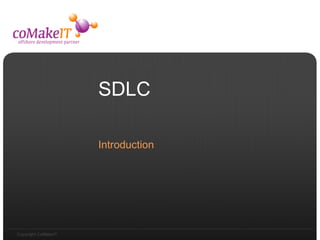Sdlc
- 2. SDLC Âŧ SDLC stands for Âŧ Systems Development Life Cycle Âŧ SDLC is a Life Cycle. Âŧ All systems have a life cycle or a series of stages they naturally undergo. Âŧ The number and name of the stages varies, but the primary stages are conception, development, maturity and decline. Âŧ The systems development life cycle (SDLC) therefore, refers to the development stage of the systemâs life cycle.
- 3. Systems Development Life Cycle Âŧ We have different names for the stages of the SDLC Âŧ Usually the stages are Âŧ Planning (just after Conception) Âŧ Analysis Âŧ Design Âŧ Implementation Âŧ Maintenance (starting Maturity) 1.3
- 4. Systems Development Life Cycle Âŧ This article highlights 6 phases: Âŧ Project Identification and Selection Âŧ Project Initiation and Planning Âŧ Analysis Âŧ Design Âŧ Implementation Âŧ Maintenance
- 5. Stages of the SDLC Sy Sy st IS st IS em 42 em 42 s 2 s 1 De An si al gn ys is
- 6. Phases of the Systems Development Life Cycle 1. Project Identification and Selection Âŧ Two Main Activities Âŧ Identification of need Âŧ Prioritization and translation of need into a development schedule Âŧ Helps organization to determine whether or not resources should be dedicated to a project. 1. Project Initiation and Planning Âŧ Two Activities Âŧ Formal preliminary investigation of the problem at hand Âŧ Presentation of reasons why system should or should not be developed by the organization
- 7. Systems Development Life Cycle Âŧ Analysis Âŧ Study of current procedures and information systems Âŧ Determine requirements Âŧ Study current system Âŧ Structure requirements and eliminate redundancies Âŧ Generate alternative designs Âŧ Compare alternatives Âŧ Recommend best alternative
- 8. Systems Development Life Cycle Âŧ Design Âŧ Logical Design Âŧ Concentrates on business aspects of the system Âŧ Physical Design Âŧ Technical specifications Âŧ Implementation Âŧ Implementation Âŧ Hardware and software installation Âŧ Programming Âŧ User Training Âŧ Documentation
- 9. Systems Development Life Cycle Âŧ Maintenance Âŧ System changed to reflect changing conditions Âŧ System obsolescence
- 10. Alternative Approaches Âŧ Prototyping Âŧ Building a scaled-down working version of the system Âŧ Advantages: Âŧ Users are involved in design Âŧ Captures requirements in concrete form Âŧ Rapid Application Development (RAD) Âŧ Utilizes prototyping to delay producing system design until after user requirements are clear
- 11. Prototyping
Editor's Notes
- #3: Development stage is critical. For example, learning behavior of humans is heavily influenced by their development period (and is the reason why money and effort is probably more effective in early stages of development). In much the same way, the success or failure of an information systems and the amount of maintenance required is dependent on the events during development.











